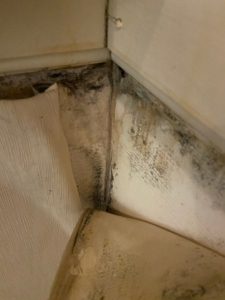MOLD: QUESTIONS AND ANSWERS

WHAT IS MOLD?
Mold is a natural part of environment that can be found almost anywhere, including inside your home. It is a fungal growth that thrives on moisture. Some molds are common in the household and present no danger to the structure or its occupants. Others can cause severe damage to your home and have serious adverse effects on indoor air quality, and by extension your health.
HOW DOES MOLD GET IN MY HOUSE?
Mold spores are nearly always present inside and outside your home. The problem arises when water intrudes and the mold finds a sustainable food source inside your home, like drywall or wood. The mold will grow, putting out increasingly more spores into the air, and ultimately impairing your indoor air quality.
Some common causes of water intrusion leading to mold include: floods, leaking pipes in kitchens and bathroom, roofs, windows, and from the foundation with a negative grade sloping towards your home. Intrusion can also occur in doorways, vents, and heating and cooling systems.
HOW DO I KNOW IF I HAVE MOLD?
Some indications that mold may be present include wood rot or water stains. If your home has had recent water damage or has excessive moisture and humidity there is potential for mold growth.
Signs of mold can also include a woody scent, the smell of mildew, rotten odors, or stale or musty air.
Mold can be visible or grow behind your walls without you seeing it. If you can see mold it is important to note that color is not an indicator of what type of mold or what hazard is associated with. Only positive lab identification can provide specific information on the type of mold, which is why sampling is necessary.
Some health issues can be related to mold growth in your home including, coughing, wheezing shortness of breath, throat irritation, headaches, sinus congestion, asthma attacks, and allergic reactions.
ARE ALL MOLDS BAD?
Not all molds are bad. Some molds like lumber molds are common in the home and present no danger to the structure or its’ occupants. Cladosporium is a common mold that can be found indoors and outdoors, it can be an allergen to those susceptible. Other molds like Stachybotrys, commonly referred to as black mold can be associated with everything from headaches to cancer.
These are just to name a few, there are many common molds. Each individual has a different tolerance to molds and their effects. It is important if you have indications of mold you seek testing, especially if you are immunocompromised or have mold allergies.
HOW TO TEST FOR MOLD?
Mold can be tested with a swab or lift tape to identify they type of mold in a specific location. The swab or tape sample would typically be taken from an area that shows mold growth or water intrusion. When sent to the lab these samples provide the number of spores and the type of mold growth in that location. An indoor air quality sample will help determine the mold species in the air and is compared with an outdoor air or control sample from outside the home. Often the same molds that are on the outside will also be present on the inside.
Beta Property Inspections in collaboration with IMS laboratories provides an easy to read mold analysis reports. These reports are generated from the samples provided and give the type of mold invading your home along with descriptions of those types of mold.





Leave a Reply
Want to join the discussion?Feel free to contribute!